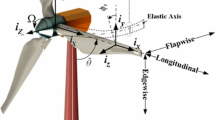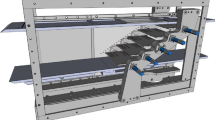Abstract
The parameter sensitivities affecting the flutter speed of the NREL (National Renewable Energy Laboratory) 5-MW baseline HAWT (horizontal axis wind turbine) blades are analyzed. An aeroelastic model, which comprises an aerodynamic part to calculate the aerodynamic loads and a structural part to determine the structural dynamic responses, is established to describe the classical flutter of the blades. For the aerodynamic part, Theodorsen unsteady aerodynamics model is used. For the structural part, Lagrange’s equation is employed. The flutter speed is determined by introducing “V–g” method to the aeroelastic model, which converts the issue of classical flutter speed determination into an eigenvalue problem. Furthermore, the time domain aeroelastic response of the wind turbine blade section is obtained with employing Runge-Kutta method. The results show that four cases (i.e., reducing the blade torsional stiffness, moving the center of gravity or the elastic axis towards the trailing edge of the section, and placing the turbine in high air density area) will decrease the flutter speed. Therefore, the judicious selection of the four parameters (the torsional stiffness, the chordwise position of the center of gravity, the elastic axis position and air density) can increase the relative inflow speed at the blade section associated with the onset of flutter.
摘要
本文以NREL 5MW 风力机为对象研究了影响风力机叶片经典颤振速度的关键参数。首先, 建 立了描述叶片颤振的气弹模型, 该模型由叶片气动模型和结构动力模型耦合而成, 其中气动部分为 Theodorsen 非定常气动力模型, 结构部分根据拉格朗日方程得到。然后, 采用“V–g”方法实现了气弹 模型的数学求解, 将带有复数的方程组求解转化为特征值求解问题。最后, 采用龙哥库塔法求解得到 了叶片在时域内的气弹响应。结果表明, 降低叶片扭转刚度、将叶片截面质心或弹性轴位置向叶片前 缘移动、或将风力机置于高空气密度区域将会降低叶片的颤振临界速度, 即叶片更容易发生颤振。因 此, 综合考虑叶片扭转刚度、截面质心或弹性轴位置以及空气密度对提高叶片颤振临界速度至关重要。
Similar content being viewed by others
References
PEERINGA J, BROOD R, CEYHAN O, ENGELS W, de WINKEL G. Up wind 20MW wind turbine pre-design [R]. Petten: Energy Research Center of the Netherlands, 2011.
HAU E. Wind turbines-fundamentals, technologies, application, economics [J]. IEEE Electrical Insulation Magazine, 2003, 19(2): 48.
BIR G, JONKMAN J. Aeroelastic instabilities of large offshore and onshore wind turbines [C]//EAWE 2007 Torque. Lyngby: IOP, 2007: 1–19.
HANSEN MOL, SØRENSEN J N, VOUTSINAS S, SØRENSEN N, MADSEN H A. State of the art in wind turbine aerodynamics and aeroelasticity [J]. Progress in Aerospace Sciences, 2006, 42(4): 285–330.
LUNDSAGER P, PETERSEN H, FRANDSEN S. The dynamic behaviour of the stall-regulated Nibe A wind turbine. Measurements and a model for stall-induced vibrations [R]. Roskilde: Risø National Laboratory, 1981.
STIESDAL H. Extreme wind loads on stall regulated wind turbines [C]//Proceedings of the 16th British Wind Energy Association Conference. Stirling: BWEA, 1994: 101–106.
WANG L, LIU X, RENEVIER N, STABLES M, HALL G M. Nonlinear aeroelastic modelling for wind turbine blades based on blade element momentum theory and geometrically exact beam theory [J]. Energy, 2014, 76: 487–501.
RAFIEE R, TAHANI M, MORADI M. Simulation of aeroelastic behavior in a composite wind turbine blade [J]. Journal of Wind Engineering and Industrial Aerodynamics, 2016, 151(1): 60–69.
HAYAT K, LECEA A, MORIONES C D, HA S K. Flutter performance of bend–twist coupled large-scale wind turbine blades [J]. Journal of Sound and Vibration, 2016, 370(1): 149–162.
LOBITZ D W. Aeroelastic stability predictions for a MW-sized blade [J]. Wind Energy, 2004, 7(3): 211–224.
LOBITZ D W, VEERS P S. Aeroelastic behavior of twist-coupled HAWT blades [J]. AIAA Paper, 1998, 98(29): 75–83.
BAXEVANOU C, CHAVIAROPOULOS P, VOUTSINAS S, VLACHOS N. Evaluation study of a Navier–Stokes CFD aeroelastic model of wind turbine airfoils in classical flutter [J]. Journal of Wind Engineering and Industrial Aerodynamics, 2008, 96(8): 1425–1443.
HOOGEDOORN E, JACOBS G B, BEYENE A. Aero-elastic behavior of a flexible blade for wind turbine application: A 2D computational study [J]. Energy, 2010, 35(2): 778–785.
DRELA M. An analysis and design system for low Reynolds number airfoil aerodynamics [C]//Low Reynolds Number Airfoil Aerodynamics. Indiana: Springer Berlin Heidelberg, 1989: 1–12.
LI L, LI Y, LV H, LIU Q. Flapwise dynamic response of a wind turbine blade in super-harmonic resonance [J]. Journal of Sound and Vibration, 2012, 331(17): 4025–4044.
MO W, LI D, WANG X, ZHONG C. Aeroelastic coupling analysis of the flexible blade of a wind turbine [J]. Energy, 2015, 89(1): 1001–1009.
OWENS B C, GRIFFITH D, RESOR B R, HURTADO J E. Impact of modeling approach on flutter predictions for very large wind turbine blade designs [C]//Proceedings of the American Helicopter Society (AHS) 69th Annual Forum. Arizona: AHS, 2013: 21–23.
HANSEN M H. Aeroelastic instability problems for wind turbines [J]. Wind Energy, 2007, 10(6): 551–577.
THEODORSEN T. General theory of aerodynamic instability and the mechanism of flutter [R]. Washington, DC: National Advisory Committee for Aeronautics, 1949: 291–313.
WRIGHT J R, COOPER J E. Introduction to aircraft aeroelasticity and loads [M]. Chichester: John Wiley & Sons, 2008.
GWIN L, TAYLOR R. A general method for flutter optimization [J]. AIAA Journal, 1973, 11(12): 1613–1617.
JONKMAN J M, BUTTERFIELD S, MUSIAL W, SCOTT G. Definition of a 5-MW reference wind turbine for offshore system development [R]. Colorado: National Renewable Energy Laboratory Golden, 2009.
LINDENBURG C. Aeroelastic modelling of the LMH64-5 blade [R]. Petten: Energy Research Center of the Netherlands, 2002.
Author information
Authors and Affiliations
Corresponding author
Additional information
Foundation item: Project(2015B37714) supported by the Fundamental Research Funds for the Central Universities of China; Project(51605005) supported by the National Natural Science Foundation of China; Project(ZK16-03-03) supported by the Open Foundation of Jiangsu Wind Technology Center, China; Project([2013] 56) supported by the First Group of 2011 Plan of Jiangsu Province, China
Rights and permissions
About this article
Cite this article
Gao, Q., Cai, X., Guo, Xw. et al. Parameter sensitivities analysis for classical flutter speed of a horizontal axis wind turbine blade. J. Cent. South Univ. 25, 1746–1754 (2018). https://doi.org/10.1007/s11771-018-3865-x
Received:
Accepted:
Published:
Issue Date:
DOI: https://doi.org/10.1007/s11771-018-3865-x




